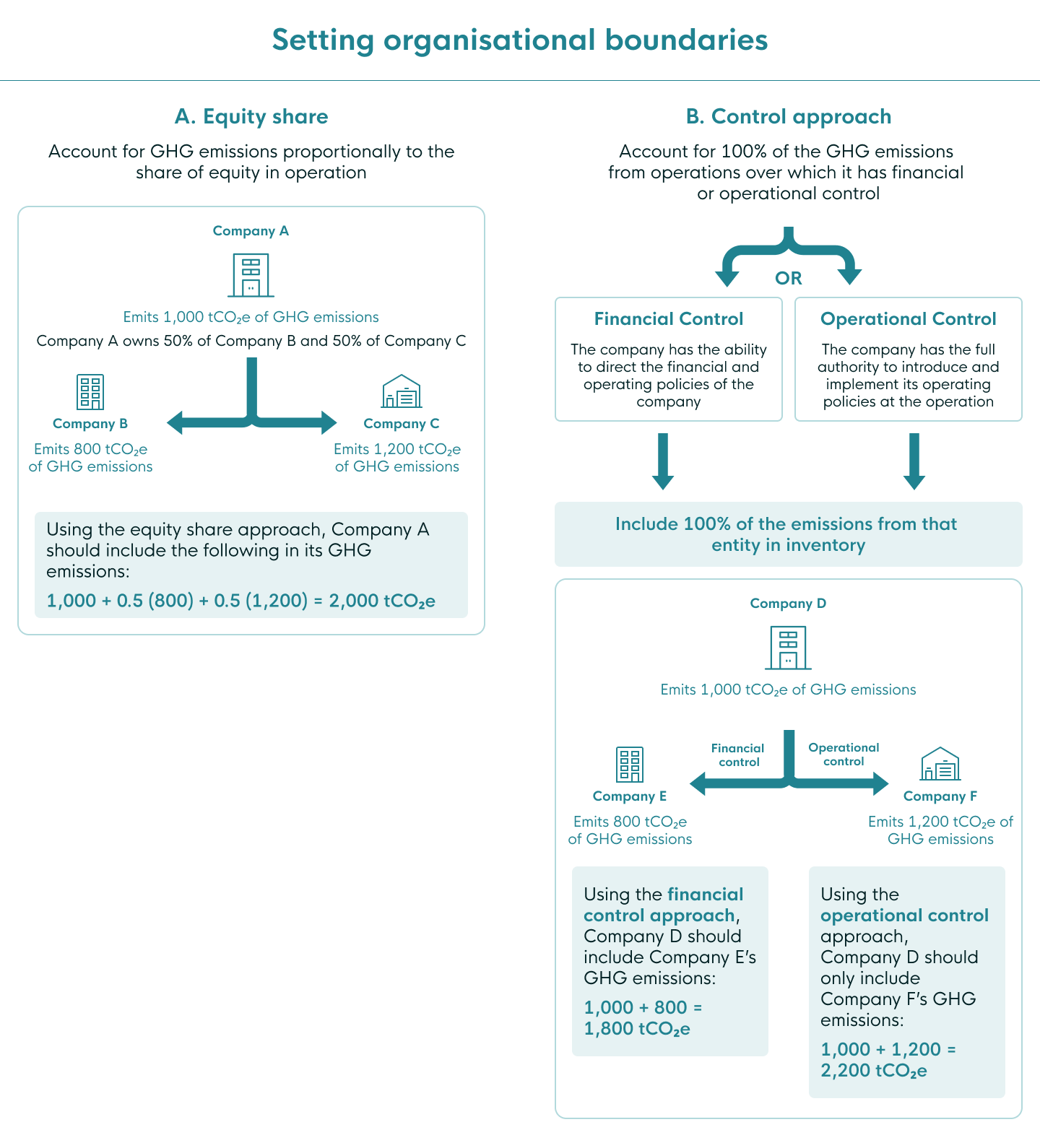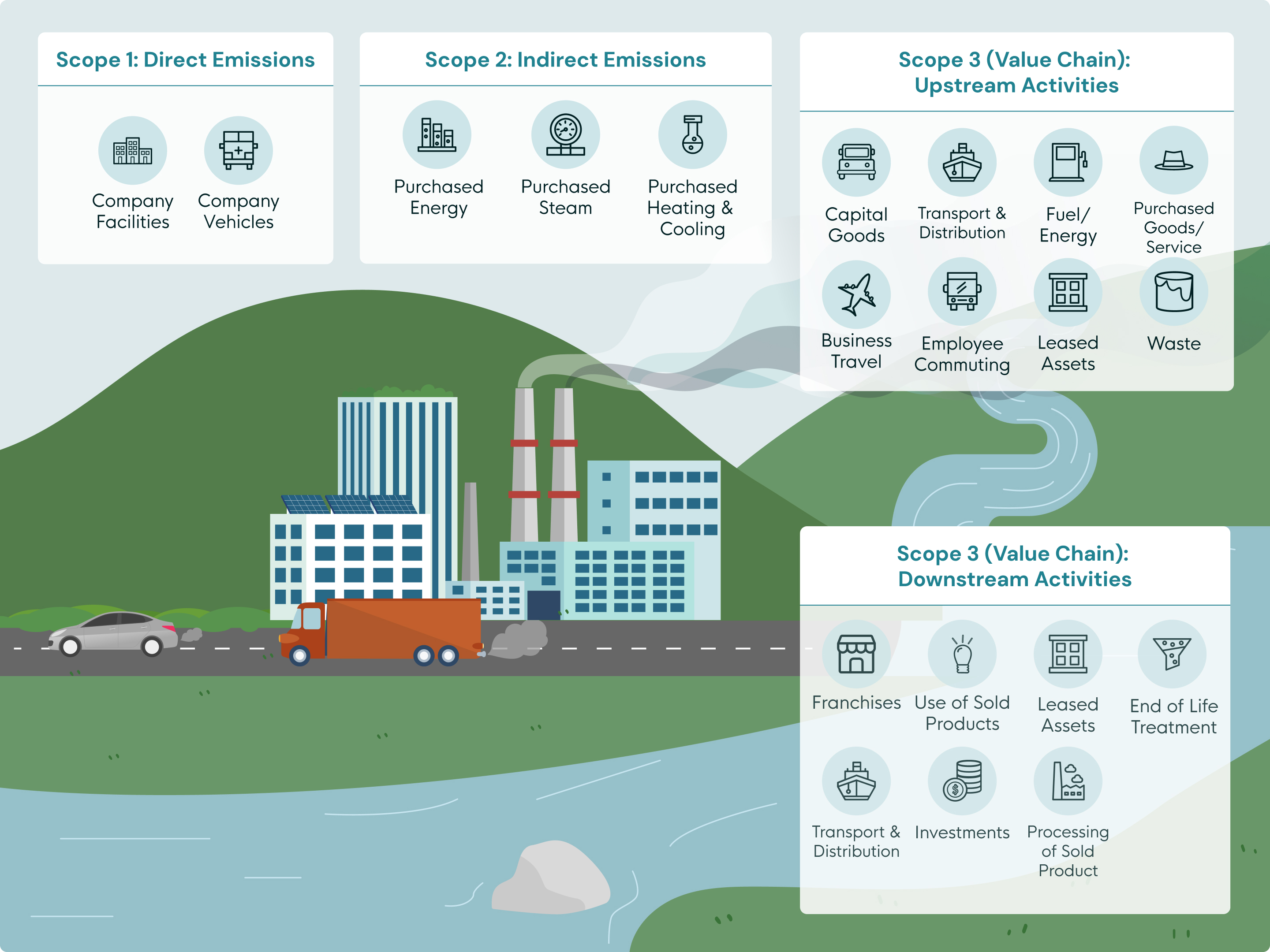Stage 2 (MEASURE): Identify relevant areas for first-step interventions
Identify your sources of emissions and energy consumption and calculate your greenhouse gas emissions.
2.1 Pinpointing emission sources and energy consumption
Businesses should start by conducting a comprehensive accounting of Greenhouse Gas (GHG) emissions that the organisation is responsible for - also known as determining an organisation's GHG inventory, or carbon footprint.
To do so, businesses can refer to international carbon accounting standards. The GHG Protocol and ISO 14064 are two of the most widely adopted international standards for carbon emissions accounting standards at the organisation level.

DID YOU KNOW?
Although the GHG Protocol and ISO 14064 adopt similar principles and steps for organisations to identify, calculate and report GHG emissions, the GHG Protocol provides a more comprehensive guidance and is more widely used and referenced by voluntary and mandatory reporting programmes, initiatives, and platforms, such as the Carbon Disclosure Project (CDP), the Global Reporting Initiative (GRI), the International Sustainability Standards Board (ISSB) and the Science Based Targets initiative (SBTi). As such, we have referenced the GHG Protocol’s guidance for this section.

You can follow the 4 steps below to start determining your company's GHG inventory:
Step 1: Establish an organisational boundary
Start by selecting one of the following approaches to determine your organisational boundary for carbon accounting.
A. Equity Share Approach: This approach involves looking at all the entities in which your company holds an ownership interest in. GHG emissions attributable to your company will be proportionate to the share of equity that your company holds.
B. Control Approach: This involves emissions from all operations that your company has financial or operational control over. Operational control is the full authority over the operating policies of the entity, and financial control is the ability to direct financial and operating policies.



TIP:
If your company does not wholly own all its operations, the operational control approach is more often used by companies as it is directly correlated to your ability to control emissions.


Resources for you
Standards, Frameworks, Certifications - Carbon Emissions and Energy Management
GHG Protocol
SS ISO 14064-1:2021 Greenhouse gases - Part 1
TR ISO / TR 14069:2020 Greenhouse gases
Step 2: Identify a base year and establish a baseline
Choose your baseline year carefully - it should be recent enough to reflect your current business operations, ideally within the past two years, whilst having comprehensive and reliable emissions data available. The baseline year should represent a typical year without major anomalies that could skew future comparisons. This baseline year will serve as your reference point, enabling you to track progress and measure the effectiveness of your carbon reduction initiatives over time.
|
Base year acts as a reference point with which current and future emissions can be compared to. Baseline data refers to the data collected over the entire calendar year of the base year. |
Step 3: Identify business activities that emit GHG emissions
Understanding the sources of your carbon emissions forms the foundation of any effective reduction strategy. The GHG Protocol classifies emissions into three distinct scopes:
- Scope 1 - Direct emissions: These encompass emissions that your company directly generates and controls, including those from your manufacturing facilities, company-owned vehicles, and on-site fuel combustion.
- Scope 2 - Indirect energy emissions: This category covers emissions associated with purchased utilities, primarily electricity, heating, and cooling. While these emissions occur at the point of energy generation rather than your facilities, they remain your company's responsibility as the end consumer.
- Scope 3 - Value chain emissions: This represents the broadest and often most significant category, encompassing all other indirect emissions throughout your value chain. It spans from upstream activities such as raw material sourcing and supplier operations to downstream impacts including product transportation, use, and end-of-life disposal. These emissions, though harder to measure, frequently constitute the largest portion of a company's carbon footprint.

TIP:
Businesses that are just starting on their sustainability journey should focus on measuring their Scope 1 and 2 emissions for a start. Once you are familiar with this process, you can expand your efforts to include Scope 3 emissions.



- Start by mapping key operations that contribute to your emissions, such as manufacturing processes, facility energy consumption, and transportation.
- While achieving complete emissions coverage may seem daunting, you can start by capturing activities that constitute at least 95% of your total carbon footprint, before progressively working to account for the remaining 5% of your emissions to achieve a full assessment.
Step 4: Collect business activity data
Implement a framework to gather detailed data for each identified emission source. For office operations, track electricity consumption by compiling utility bills. When monitoring emissions from your vehicle fleet, maintain detailed records of fuel usage from petrol station bills and vehicle odometer readings.
Examples of activity data
2.2 Calculate carbon emissions
The following formula is used to calculate GHG emissions arising from any business activity:

Scope 1 emissions
It is recommended for businesses to use geography-specific or activity-specific emission factors for greater accuracy. For companies which are liable for Singapore's carbon tax, they should apply the default emission factors published by NEA, which takes reference from emission factors published by the Intergovernmental Panel on Climate Change (IPCC). Businesses can also obtain localised emission factors from the Singapore Emissions Factors Registry, which provides more than 200 emission factors from government agencies.
Scope 2 emissions
Based on the GHG Protocol, the following two methods can be used to determine GHG emissions created by electricity generation:
A. Location-based method: Location-based method reflects the average emissions intensity of grids on which energy consumption occurs (i.e. based on average GEF data). For this method, you require the grid emission factor specific to the grid that supplies your electricity which can be obtained directly from the national authority (Energy Market Authority in Singapore).
B. Market-based method: Market-based method reflects the emissions from electricity that companies have purposefully chosen (i.e. based on an emissions rate or emissions per MWh of generation facilities associated with contractual instruments such as Power Purchase Agreements (PPAs) and Renewable Energy Certificates (RECs)). For this method, you can use the emission factor associated with the contractual instrument for your respective sources of electricity.

DID YOU KNOW?
The Grid Emission Factor (GEF) measures the amount of carbon emissions per unit of electricity generated. This includes all electricity sources feeding into the grid, including fossil fuels such as natural gas, renewable sources such as solar, and alternative energy solutions like waste-to-energy plants.

Resources for you
GHG Protocol Corporate Accounting and Reporting Standard
GHG Protocol Scope 2 Guidance
Singapore Standard (SS) 673: Code of Practice for Renewable Energy Certificates
Scope 3 emissions
Begin by mapping your value chain to identify Scope 3 emission sources, before determining if any categories should be excluded. Refer to the the GHG Protocol for the criteria on identifying relevant Scope 3 activities.
You should then prioritise your data collection efforts on Scope 3 categories that are expected to have the most significant GHG emissions and reduction opportunities that are most relevant to your company’s goals.
Refer to the GHG Protocol Technical Guidance for Calculating Scope 3 Emissions for more specific information on calculating the emissions for each scope 3 category.
Resources for you
2.3 Find the carbon calculator that is right for your business
As you begin your GHG accounting journey, you can consider tapping on ESG data platforms that help to streamline and automate the calculation process. One example is Gprnt, which was launched by the Monetary Authority of Singapore (MAS) to help all businesses get started on sustainability reporting and emissions calculation. Businesses can use Gprnt's disclosure utility to seamlessly complete a free emissions report that is integrated with government databases.
Businesses can also explore the NetZeroHub.SG, a platform spearheaded by the Singapore Business Federation (SBF), which provides a list of digital solutions and providers that you can consider adopting to support your carbon accounting journey.